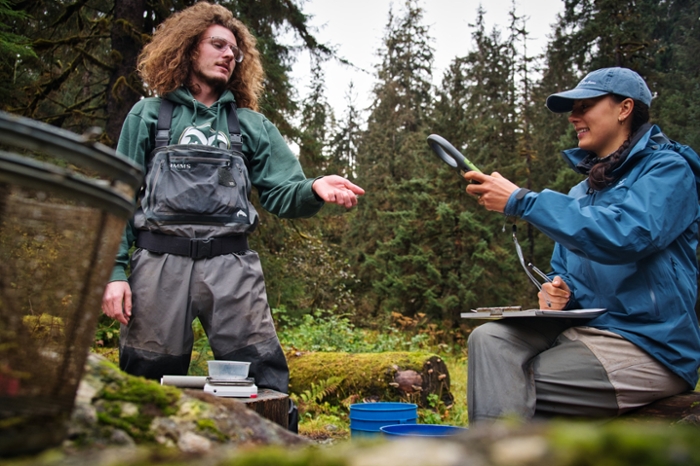Stream hydrology impacts whether salmon can capitalize on pink salmon nutrients, new research suggests

Each July, Juneau’s streams fill with an abundant, nutrient-dense resource from the ocean: spawning pink salmon. The arrival of pink salmon eggs into coastal watersheds brings a large pulse of nutrients to freshwater ecosystems, marking an important phase of growth for stream-rearing salmon before they smolt and begin their sea-ward migration. New research, led by ACRC graduate student Kevin Fitzgerald, points to stream hydrology as an important factor influencing whether juvenile salmon are able to capitalize on the pink salmon resource pulse.
Published in the Journal of Animal Ecology this fall, the paper examines how hydrologic variation in a Juneau stream (Montana Creek) impacts the foraging success and growth patterns of juvenile coho salmon and Dolly Varden. Before the pink salmon pulse, these fish species primarily rely on macroinvertebrates drifting in the stream column for food. Streamflow can significantly influence the availability of these drifting macroinvertebrates, subsequently impacting foraging and growth conditions for fish. Juvenile salmon must also exceed a minimum body size to consume salmon eggs (known as gape limit) by the time that pink salmon arrive in the stream. Thus, early-season streamflow patterns may actually influence whether juvenile salmon are able to access marine-derived resources associated with pink salmon spawning.
The team, including ACRC researchers Jason Fellman and Claire Delbecq alongside USFS, UAF, and USGS scientists, collected fish stomach content samples at daily to weekly intervals from April to October of 2021, and analyzed these samples to determine the relationship between fish consumption rate and streamflow. They then used these relationships in a bioenergetic model to simulate coho salmon growth among contrasting hydrologic years to further explore the influence that hydrologic variation may have on juvenile salmon growth.
They found that the juvenile salmon consumed the most during the highest observed flow conditions, as the elevated water levels incorporated more invertebrates into the stream channel and improved fish foraging conditions. In contrast, they found that juvenile salmon consumed the least during severe low-water periods, likely due to decreased availability of drifting invertebrate prey and greater competition for food resources when fish became condensed within shrinking pool habitats.
Their bioenergetic simulations revealed large differences in juvenile salmon growth between high and low water years. In high water years, the simulated end-of-year body size for young-of-year (hatched in 2021) coho salmon far exceeded the gape limit for egg consumption. In contrast, the two lowest water years (2018 and 2019) produced end-of-year body sizes significantly smaller than the pink salmon egg gape limit (~ 70 mm). These findings suggest that early season streamflow conditions have the potential to mediate juvenile salmon access or exclusion to important marine-derived resources during the later pink salmon pulse. During severe low-water years, juvenile salmon may remain dependent on macroinvertebrate prey year-round instead of consuming salmon eggs during the warmest summer months. This is noteworthy because salmon eggs are up to three times as energy-dense as invertebrate prey, and increased salmon egg consumption has been shown to more than double the mid-summer body mass of juvenile coho salmon relative to fish that are unable to access salmon eggs. Moreover, numerous studies have linked improved freshwater salmon growth to increased population productivity and found that smolt body size is influential to marine survival.
The authors note it is important to recognize that these simulations are simplified from reality, and cannot account for possible behavioral responses like fish movement away from suboptimal low-flow conditions. For instance, in streams that receive hydrologic inputs from a diversity of sources like Montana Creek, fish may be able to relocate away from low-water conditions in areas with rain-driven hydrologic regimes into tributaries with elevated water levels from snow and meltwater. In watersheds that have primarily precipitation-based hydrologic inputs, fish movement is unlikely to provide an effective buffer against low-water conditions induced by drought.
Hydrologic regimes throughout the coastal Gulf of Alaska are anticipated to experience more high flow events and more severe low flow events due to climate change. This research highlights one possible way that increased flow variability could intensify year-to-year variation in juvenile coho salmon growth and productivity. With one of the largest and most productive coho salmon populations in the world, changing hydrologic conditions in the Tongass must continue to be studied to better understand how the capacity for watersheds to support juvenile salmon may be impacted, and how deleterious effects of hydrologic change can best be mitigated.